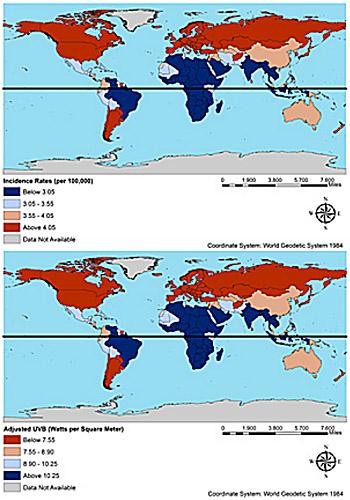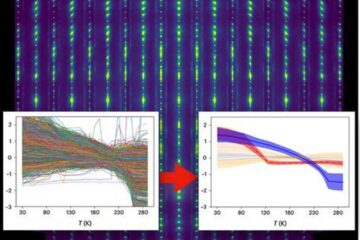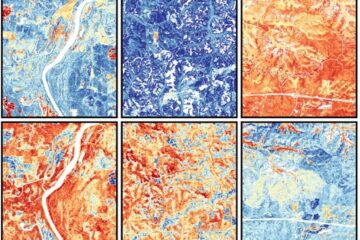Pancreatic cancer risk linked to weak sunlight

Maps depict global incidence rates of pancreatic cancer (per 100,000) and ultraviolet B radiation (watts per square meter). Credit: UC San Diego School of Medicine
Writing in the April 30 online issue of the Journal of Steroid Biochemistry and Molecular Biology, researchers at University of California San Diego School of Medicine report pancreatic cancer rates are highest in countries with the least amount of sunlight. Low sunlight levels were due to a combination of heavy cloud cover and high latitude.
“If you're living at a high latitude or in a place with a lot of heavy cloud cover, you can't make vitamin D most of the year, which results in a higher-than-normal risk of getting pancreatic cancer,” said first author Cedric F. Garland, DrPH, adjunct professor in the Department of Family Medicine and Public Health and member of UC San Diego Moores Cancer Center.
“People who live in sunny countries near the equator have only one-sixth of the age-adjusted incidence rate of pancreatic cancer as those who live far from it. The importance of sunlight deficiency strongly suggests – but does not prove – that vitamin D deficiency may contribute to risk of pancreatic cancer.”
Limited foods naturally contain vitamin D. Fatty fish, such as salmon and tuna, are good sources; beef liver, cheese and egg yolks provide small amounts. Vitamin D is often added as a fortifying nutrient to milk, cereals and juices, but experts say most people also require additional vitamin D to be produce by the body when skin is directly exposed to sunlight. Specifically, ultraviolet B radiation. Skin exposed to sunshine indoors through a window will not produce vitamin D. Cloudy skies, shade and dark-colored skin also reduce vitamin D production.
The UC San Diego team, led by Garland and Edward D. Gorham, PhD, associate professor, had previously shown that sufficient levels of a metabolite of vitamin D in the serum, known as 25-hydroxyvitamin D was associated with substantially lower risk of breast and colorectal cancer. The current paper is the first to implicate vitamin D deficiency with pancreatic cancer.
Researchers studied data from 107 countries, taking into account international differences and possible confounders, such as alcohol consumption, obesity and smoking. “While these other factors also contribute to risk, the strong inverse association with cloud-cover adjusted sunlight persisted even after they were accounted for,” said Garland.
UC San Diego researchers had previously identified an association of high latitude with a higher risk of pancreatic cancer. Garland said the new study advances that finding by showing that an estimate of solar ultraviolet B that has been adjusted for heavy cloud cover produces an even stronger prediction of risk of pancreatic cancer.
Pancreatic cancer is the 12th most common cancer in the world, according to World Cancer Research Fund International, with 338,000 new cases diagnosed annually. Incidence rates are highest in North America and Europe; lowest in Africa and Asia. It is the seventh most common cause of death from cancer.
###
Coauthors of the study include Raphael E. Cuomo, Kenneth Zeng and Sharif B. Mohr, all at UC San Diego.
Funding for this research came, in part, from UC San Diego Department of Family Medicine and Public Health.
Media Contact
All latest news from the category: Health and Medicine
This subject area encompasses research and studies in the field of human medicine.
Among the wide-ranging list of topics covered here are anesthesiology, anatomy, surgery, human genetics, hygiene and environmental medicine, internal medicine, neurology, pharmacology, physiology, urology and dental medicine.
Newest articles

Machine learning algorithm reveals long-theorized glass phase in crystal
Scientists have found evidence of an elusive, glassy phase of matter that emerges when a crystal’s perfect internal pattern is disrupted. X-ray technology and machine learning converge to shed light…

Mapping plant functional diversity from space
HKU ecologists revolutionize ecosystem monitoring with novel field-satellite integration. An international team of researchers, led by Professor Jin WU from the School of Biological Sciences at The University of Hong…

Inverters with constant full load capability
…enable an increase in the performance of electric drives. Overheating components significantly limit the performance of drivetrains in electric vehicles. Inverters in particular are subject to a high thermal load,…





















